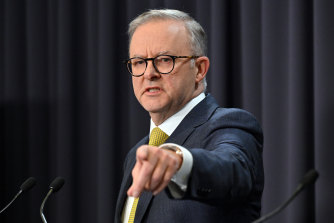Prime Minister Anthony Albanese says Australia has a once-in-a-lifetime chance to become a renewable energy superpower by transforming the country’s old coal-dominated electricity grid, helping its regional allies to shift to net zero emissions and tapping booming green investments.
Australia has among the highest growth in renewable energy as well as some of the best critical minerals deposits and Albanese on Tuesday, in his first major speech on climate change as prime minister, will signal his intention to share our technology, resources and expertise with counties such as India and Indonesia.
Prime Minister Anthony Albanese.Credit:Mick Tsikas
“Australia is eager and ready to do our part,” he will say at the Sydney Energy Forum. “Together, we can ensure better access to affordable, reliable and secure clean energy right across the Indo-Pacific, as we move to a net zero world.”
The forum is part of the Quad partnership between Japan, US, India and Australia where Albanese will meet with top officials from these nations as well as from Indonesia, which is a special inclusion as a regional partner.
Indo-Pacific nations must build six times the current amount of renewable power installed across the region and triple the investment that is flowing into clean technologies to hit net zero greenhouse gases by 2050.
“The numbers shouldn’t daunt us. They should energise us,” Albanese will say.
China dominates the global supply of critical minerals, which are needed for renewables and clean technologies.
Albanese will say Australia can grow new industries along with global energy security by developing and exporting its abundant reserves of rare earths, aluminium, lithium, copper, cobalt and nickel.
“Australia has the workers, the resources and the capacity to become a renewable energy superpower,” he will say.
“Greater diversity and security of critical minerals extraction and processing, greater diversity of clean technology manufacturing, and security of clean energy supply are essential for managing supply and strategic risks.”
The Labor Party won the May federal election with a commitment to raise the share of renewable energy in the electricity grid to 82 per cent by 2030, which Albanese will claim will “unlock $52 billion of private sector investment in Australian industries”. But enormous challenges remain.
The fallout from Russia’s invasion of Ukraine was deepening a global energy crisis and piling enormous pressure on Australia’s east-coast power network, where authorities remain on high alert over blackout risks and spiking prices.
Audrey Zibelman, the former head of the Australian Energy Market Operator (AEMO), said the nation’s electricity grid was undergoing a massive transformation forcing it to rapidly adapt to some challenges well in advance of other countries across the globe.
The influx of renewable energy and world-leading uptake of rooftop solar panels pile mounting pressure on Australia’s fleet of large coal-fired power stations.
Zibelman said AEMO’s Integrated System Plan – a 30-year road map to guide the investments required to shift away from fossil fuels – was a critical tool for understanding “ahead of time” what was needed for a successful transition.
“You can’t simply say, ‘We’re going to tack on an incremental change,’ you need to step back and fundamentally relook at it and be willing to take bold steps,” she told The Age and the Sydney Morning Herald ahead of the Sydney Energy Forum.
“I think what we are seeing in Australia and how we are grappling with these challenges are the types of things everyone is going to have to figure out as they go along.”
Zibelman left AEMO in 2020 and is now the head of climate projects at Google sister company X in the US. She said access to better data and modelling to more accurately forecast conditions in the electricity grid would prove critical for market operators and policymakers in managing the energy transition.
Australia has signed up to the Paris Agreement to limit average global temperature rise to 1.5 degrees.
Labor’s climate change policy includes a commitment to cut emissions 43 per cent by 2030, a goal that if the rest of the world followed, leading think tank Climate Analytics found would lead to global warming of more than 2 degrees.
Albanese will also say Australia can cash in on booming demand for clean energy through major private power export projects, such as Sun Cable’s to bring solar energy from the Northern Territory to Singapore via an undersea cable and the Asian Renewable Energy Hub in Western Australia’s Pilbara region.
Cut through the noise of federal politics with news, views and expert analysis from Jacqueline Maley. Subscribers can sign up to our weekly Inside Politics newsletter here.
Most Viewed in Politics
From our partners
Source: Read Full Article
